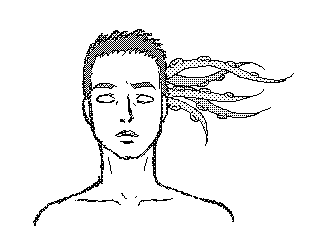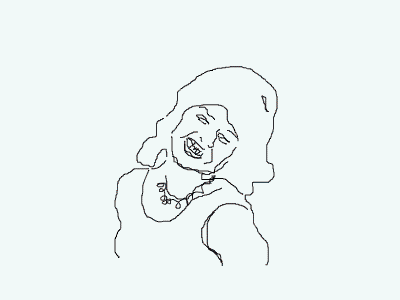View current page
...more recent posts



artists unknown
Rhizome.org 2007-2008 Commissions* Considered as XYZ Art
"once a process (i like to say algorithm) Y is set up, you can mess about trying to figure out what X you can put in to get what Z, and then what's the best Z, and then what X will give it to you..." (Paul B. Davis on the XYZ tendency in computercentric art). That tendency crosses over from the digital/new media realm (Rhizome) to by-the-numbers conceptual art in the gallery world (VVork). Common features are a distinct grammar of subject-verb-object and a noble or socially useful goal. It is especially prevalent in tech art, which tends to mimic the scientific method's successful means of getting results. Once the "experiment" is performed, voila, Art.
1.) AddArt Member Selection
by Steve Lambert with Evan Harper
AddArt is a Firefox extension (Y) which replaces advertising images on web pages (X) with art images from a curated database (Z).
2.) Ebay-Generator
by Ubermorgen.com (Alessandro Ludovico and Paolo Cirio)
Ebay-Generator (Y) will generate songs (Z) based on the public data mined from Ebay sellers and buyers (X). Users' rating, sold objects, times and frequency of transactions and other data will be automatically transformed into a structured text, which a supercollider-application will use to generate music and lyrics.
3.) ShiftSpace - An OpenSource Layer Above Any Website
by Dan Phiffer and Mushon Zer-Aviv
While the Internet's design is widely understood to be open and distributed, control over how users interact online has given us largely centralized and closed systems. ShiftSpace is an Open Source platform (Y) that attempts to subvert this trend by providing a new public space on the web. By pressing the [Shift] + [Space] keys, a ShiftSpace user can invoke a new meta layer (Z) above any web page (X) to browse and create additional interpretations, contextualizations and interventions using various authoring tools.
4.) The Wrench
by Knifeandfork (Sue Huang and Brian House)
The Wrench will recast Primo Levi's The Monkey's Wrench (X) into a mobile phone text-message exchange between participants and an artificially-intelligent agent (Z). Taking place over the course of a week, the dialogue is not pre-determined; it employs Knifeandfork's nonlinear narrative software engine (Y). The system is intended to present a convincingly human agent within a realtime plot progression. The AI will have specific, dynamic narrative goals for each interaction, designed to intertwine the lives of the character and participant through the ubiquitous yet restrictive communication channel of text-messaging.
5.) zHarmony Member Selection
by conglomco.org (Tyler Jacobsen & Kim Schnaubert)
zHarmony is an addition (Y) to Rhizome that will combine the Compatibility Matching System of online relationship services like eHarmony with Rhizome's existing database of artists (X). zHarmony will produce a unique artist profiling system that can automatically match artists with like-minded collaborators (or groups of collaborators) based on multiple points of compatibility (Z).
Borderline XYZ projects:
6.) Eavesdropping
by Jack Stockholm
Eavesdropping is a networked audio system (Y) designed for guerilla performance (Z) to raise awareness of our ambient communication in public spaces (X). This project highlights the intentionality and exhibitionism of bringing our private actions into the public sphere.
7.) VF, Virta-Flaneurazine-SL, Proposal for Clinical Study Member Selection
by Will Pappenheimer and John Freeman
Virta-Flaneurazine-SL is a potent programmable "mood changing" drug (Y) for Second Life (SL). A member of the "Wanderment" family of psychotropic drugs; when ingested it automatically causes the bearer (X) to aimlessly roam the distant lands of SL for up to a full day. As the prograchemistry takes effect, users find themselves erratically teleporting to random locations, behaving strangely, seeing digephemera and moving in circuitous paths (Z). Many users report the experience allows them to see SL freed from its limitations as a fast growing grid of investment properties.
Non XYZ projects:
8.) Phrenology
by Melanie Crean with Chris Sugrue and Paul Geluso
Phrenology will investigate the perception of space, whether real, virtual or imagined, though writings created by incarcerated women in a workshop the artist will teach at Bedford Hills Correctional Facility. The piece will consist of a series of 360 degree photographic panoramas that interconnect through text included in the environments. Viewers will be able to move through the different environments to read the women's writing in a form of spatial poem, accompanied by an experimental sound track based on the text. [a possible (Y) might be the traditional interpretative function of the artist but that doesn't count as an "algorithm"--the use of prison texts is a typical (X)]
9.) Jellotime.com
by Rafael Rozendaal
JelloTime.com will be a website with a single flash animation. You will see a green plate with a red Jello dessert. When you touch the jelly with your mouse, it "wobbles." It will shake and make a strange sound, the more you pull it, the more it will shake. I really want to emulate the feeling of jelly, something between solid and liquid. A feeling that is very familiar in real life that might seem strange on a computer screen. [not XYZ. more like just (X)]
10.) Remote Instructions
by Lee Walton
Remote Instructions is a web-central project that will utilize both the communication capabilities of the web and spectatorship of its users. From a central hub, Lee Walton will collaborate with strangers globally via the web and orchestrate a series of video performances that will take place in real cities, neighborhoods, villages and towns around the world. A Remote Instructions website will be created to host video projects and promote networking among collaborators. [too complicated to be XYZ. sounds like a lot of work, and the only person with the big picture view will be the artist]
11.) Second Life Dumpster
by eteam
In Second Life each avatar has a trash folder. Items that get deleted end up in that folder by default. The trash folder has to get emptied as often as possible, otherwise the avatars performance might diminish. But, where do deleted things end up? What are those things? Second Life Dumpster will explore these questions by starting and maintaining a public dumpster in Second Life for the duration of one year. [this is not XYZ because it is open-ended and asks questions without knowing what the answers are. it is the second of two commissions involving Second Life, the "Active Worlds of the '00s"]
Update, 2011: The Rhizome link has been changed to http://rhizome.org/editorial/2007/jun/15/rhizome-2007-08-commissions-announcement/. Please note these are elsewhere called the 2008-2009 Commissions.


